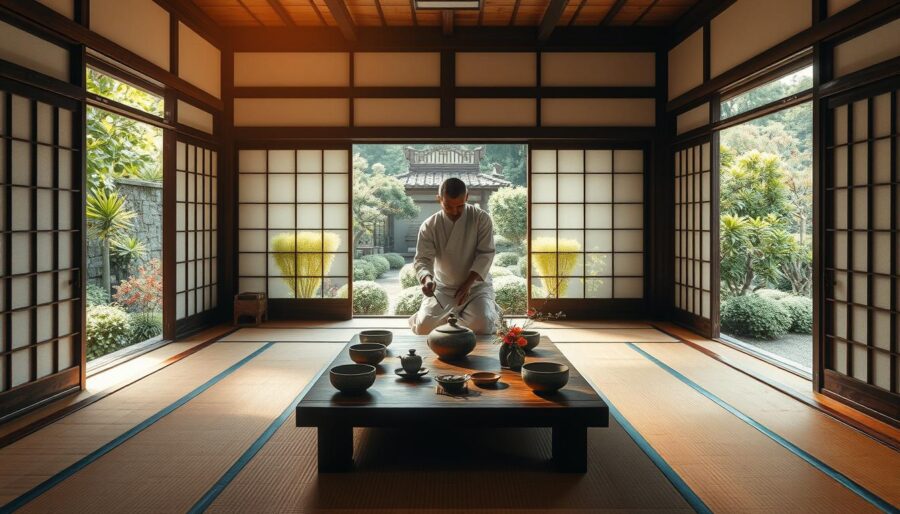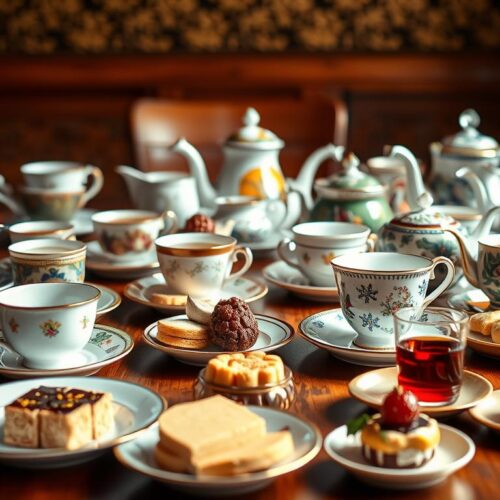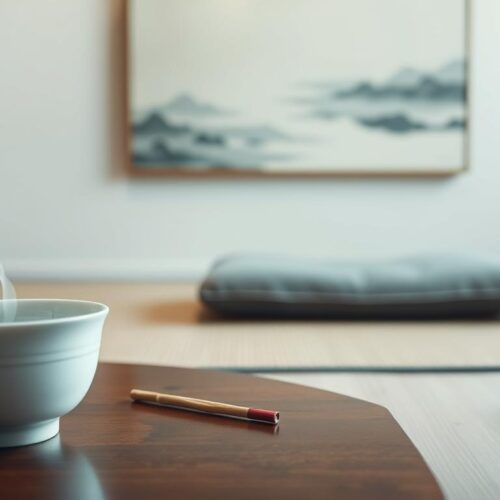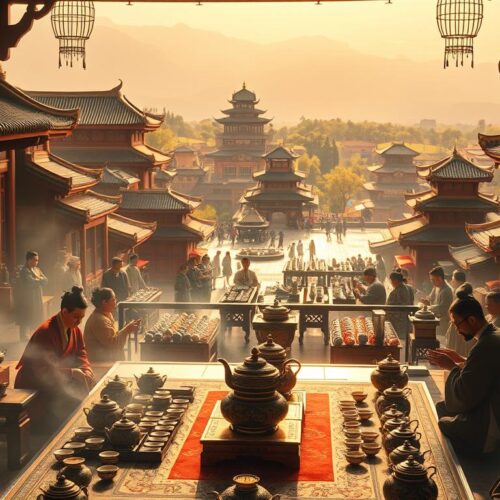The Japanese tea ceremony, Chanoyu, is more than making tea. It’s a deep dive into culture and personal reflection. In this spiritual ritual, every aspect is a call to be mindful and appreciate the simple things. Chanoyu opens a window into wabi-sabi, finding beauty in flaw.
When you take part in this ceremony, you’re joining a long-standing tradition. You also get a chance to look inside yourself and connect with others.
What is the Japanese Tea Ceremony?
The Japanese tea ceremony, or Chanoyu, is not just about making tea. It highlights harmony, respect, purity, and peace. Tea first came to Japan through Buddhist monks from China, valued for its healing powers. This ceremony turned tea drinking into a deep, philosophical act.
The tradition grew rich over centuries, teaching us to live in the moment. Making matcha, a special green tea, teaches mindfulness and simplicity. It turns each tea ceremony into a time for deep thought and gratefulness. The practice mirrors Zen Buddhism ideals of living fully and with discipline.
The Meaning of Chanoyu
Chanoyu goes beyond a simple definition; it’s deep in Japanese tea ceremony culture. It’s about welcoming guests with true kindness. The host prepares carefully, making an atmosphere of calm. This makes guests feel important and respected.
Chanoyu’s spiritual heart is in the mindfulness it encourages. Each action brings peace, helping everyone focus on the here and now. This shared time deepens bonds between host and guests, making the ceremony special. Learning about Chanoyu helps you appreciate tea and meaningful moments more.
The Elements of the Ceremony
At the heart of the Japanese tea ceremony is matcha, a special powdered green tea. It stands for harmony and purity. Its striking appearance grabs your attention. It also reflects the deep meaning of Chanoyu, the tea ceremony philosophy. Tea utensils like bowls, whisks, and kettles are also key. They’re chosen with care, showing the skill and meaning behind their use.
These tea utensils are more than just tools. They’re valued pieces that show the beauty in imperfection. This is part of the wabi-sabi aesthetic. How each item is used and cared for makes the tea ceremony more special. It lets people enjoy the tea and learn about the ceremony’s history and the craft behind it.
| Tea Utensil | Function | Symbolism |
|---|---|---|
| Chawan (Tea Bowl) | Holds matcha during preparation | Represents unity and community |
| Chasen (Tea Whisk) | Used to froth matcha | Embodies the attention to detail |
| Kama (Tea Kettle) | Heats water for tea | Signifies hospitality and warmth |
| Hishaku (Ladle) | Dispenses water | Symbolizes care and precision |
Knowing about these elements makes the tea ceremony more meaningful. It helps you deeply connect with its cultural importance.
The Role of the Host
The host of the tea ceremony plays a crucial role. Every action by the host helps create a relaxing and connecting environment. Getting the tea room ready with great care makes it a peaceful and beautiful place. This prepares everyone for the meaningful ceremony ahead.
The host must be fully present in each action, from choosing tea and tools to planning where everyone sits. This careful attention shows respect and warmth to your guests. It makes them feel part of something special. The host’s attitude should be calm and honest, so guests feel welcome and comfortable.
Check the table below for key responsibilities involved in the tea ceremony host role:
| Host Responsibility | Description |
|---|---|
| Setting the Atmosphere | Arranging the tea room with attention to detail, focusing on aesthetics and calming elements. |
| Preparing the Tea | Selecting high-quality tea and preparing it with meticulous care to enhance flavor and presentation. |
| Greeting Guests | Welcoming guests with genuine hospitality, setting a positive tone for the ceremony. |
| Conducting Rituals | Executing ritual actions with grace and mindfulness, providing a rhythmic flow to the ceremony. |
| Fostering Connection | Encouraging interaction among guests, reinforcing the sense of community and shared experience. |
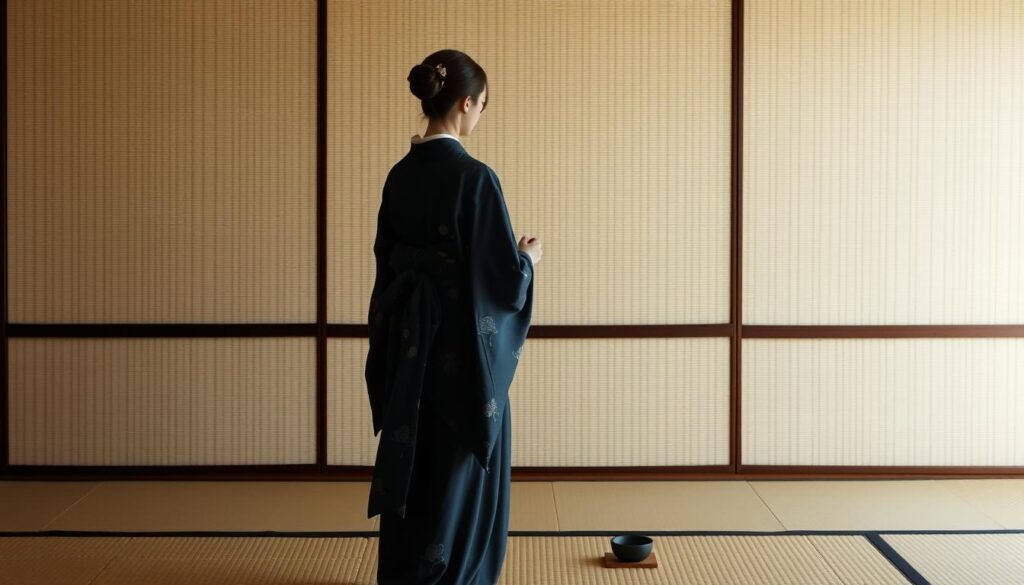
The Guest Experience
In the Chanoyu tea ceremony, guests share a deep connection and respect. It starts as soon as you enter the tea room. The way you’re seated on tatami mats makes everyone feel equal. This setup helps everyone feel close and in harmony during the ceremony.
Your role as a guest is key to the ceremony’s spirit. By following traditions like bowing and watching the tea get ready, you join a shared feeling of gratitude. Every gesture helps us live in the moment together.
The ceremony lets you dive into a peaceful world. By approaching the tea with your full attention, it becomes a calming, shared journey. It shows us the power of focusing on the simple things and connecting with those around us.
| Aspect | Description |
|---|---|
| Seating in Chanoyu | Guests sit on tatami mats, fostering equality and a sense of belonging. |
| Ritual Participation | Actions such as bowing and tea reception promote mindfulness and collective appreciation. |
| Connection | Seating arrangements and shared rituals enhance the bonds between participants. |
| Atmosphere | A tranquil, respectful ambiance encourages deep engagement and reflection. |
The Aesthetic of Wabi-Sabi
The aesthetic of wabi-sabi is central to the Japanese tea ceremony. It celebrates beauty in imperfection. This concept makes us appreciate simplicity and the beauty that fades. Each item used in the ceremony shows wabi-sabi through wear, unique textures, and natural colors.
The Japanese tea ceremony’s look aims to bring peace and thoughtfulness. Flawed utensils become the highlight, showing beauty is in being real, not perfect. This idea of accepting flaws helps everyone enjoy life’s brief moments, a key part of Japanese culture that adds depth to the ceremony.
Wabi-sabi teaches us that no two gatherings are the same, each marked by time and the elements used. As guests take part, they grow closer to their environment and to the idea that beauty is found in simple things.
Seasonal Influences on the Ceremony
Chanoyu, the Japanese tea ceremony, values nature and its cycles deeply. It celebrates the beauty of each season through special components. Choosing seasonal ingredients for Chanoyu can enhance your experience.
The host has a key role in picking seasonal items. They choose specific teas, sweets, and tableware to reflect the current season. This not only mirrors the season’s essence but also connects us to nature’s rhythms.
Using flowers in the tea ceremony is essential too. Seasonal flowers add beauty and remind us of nature’s fleeting beauty. Each flower chosen shares a story, making the ceremony special.
By blending these elements, a seasonal tea ceremony creates peace and harmony. Such care in choosing seasonal items and arranging flowers deepens our appreciation for the world’s beauty.
The Four Principles of the Tea Ceremony
The Japanese tea ceremony, known as Chanoyu, is guided by four principles: harmony (Wa), respect (Kei), purity (Sei), and tranquility (Jaku). These principles shape every part of the ceremony. They help everyone connect with each other and with their surroundings.
Harmony is key in the tea ceremony. It’s about balancing everything: the space, the tea, and the people. This balance creates a feeling of community and togetherness.
Respect is crucial too. It means seeing the value in everyone there. Courtesy is a big part of the ceremony. It makes sure everyone feels important. This respect makes the experience richer for everyone.
Purity makes the ceremony special. It’s about being mindful and clear in what you do. This isn’t just about being clean. It also means having a clear mind. This mindset helps make the tea serving peaceful, without any distractions.
Finally, tranquility is about finding peace inside. It’s key to the tea ceremony, offering a break from everyday stress. By following these principles, people enjoy the moment more. They also learn more about themselves and their world.
The Influence of Zen Buddhism
Zen Buddhism shapes the Japanese tea ceremony, known as Chanoyu. This tradition highlights the power of being mindful. By paying close attention to every move and breath, you bond deeply with yourself and nature.
Chanoyu goes beyond just making and enjoying tea. It’s a chance to dive into a meditative state. This experience boosts your love for the environment. The careful choice of flowers and tools for the tea links you closer to nature.
Zen teaches us to love simplicity and peace. It lets us reflect and see the beauty in brief moments. Engaging in this mindful ritual mixes awareness, calm, and a deep appreciation for tea artistry.
Modern Adaptations of the Tea Ceremony
The way we do the tea ceremony has changed, blending old and new. As our world changes, so does Chanoyu. Now, there are new styles of Chanoyu that keep the tradition but add fresh twists.
More people are trying cultural tea workshops, making this art more available to everyone. These workshops teach the skills and the deep thoughts behind the tea ceremony. They give people hands-on learning about the ceremony’s tools and customs, from past to present.
In both cities and the countryside, events for the modern tea ceremony draw many people. It appeals to everyone, from those just starting to those who already love it. These events help everyone see the beauty in being mindful, artistic, and welcoming in tea culture.
Learning the Art of Tea Ceremony
If you’re keen to deeply understand Chanoyu, getting involved in structured tea ceremony education is key. There are many ways to learn, including workshops, online courses, and tea schools nearby. Each method lets you uncover the deep history and philosophy behind every part of the ceremony.
An expert tea ceremony teacher offers crucial insights and advice. Learning from someone with experience doesn’t just improve your skill—it lets you feel the ceremony’s spiritual heart. Teachers bring a wealth of knowledge about traditional techniques, sharing the subtle details of this age-old art.
| Learning Method | Description | Benefits |
|---|---|---|
| In-Person Classes | Hands-on experience with direct feedback from a tea ceremony teacher. | Immediate correction of techniques and group interactions enhance learning. |
| Online Courses | Flexible learning at your own pace with video demonstrations. | Accessibility and the ability to revisit lessons as needed. |
| Workshops | Short, intensive sessions focusing on specific aspects of the ceremony. | Immersive experiences that can spark deeper interest and commitment. |
Choosing your learning path wisely, getting help from a well-versed teacher, and dedicating time to study, will deeply enrich your Chanoyu experience. This journey does more than teach you to serve tea with grace. It invites you into a deeper understanding of its cultural importance.
The Global Impact of Japanese Tea Culture
The influence of Japanese tea culture around the world is vast. It stretches far from where it began. In the United States and Europe, people are embracing the mindful way of enjoying tea. This reflects the grace and simplicity found in Chanoyu, the Japanese tea ceremony.
Thanks to cultural exchanges, more people appreciate how tea is made and enjoyed. You might see tea shops that focus on the beauty and quality of Japanese tea. The idea of mindfulness from Chanoyu is catching on. It helps people find balance in their busy lives.
Now, there are new ways of enjoying tea that mix Japan’s traditions with those from other places. Some cafes serve creative drinks that honor Japanese tea but add local tastes. This shows how tea can bring people together. It’s a drink that fits with many customs and celebrations.
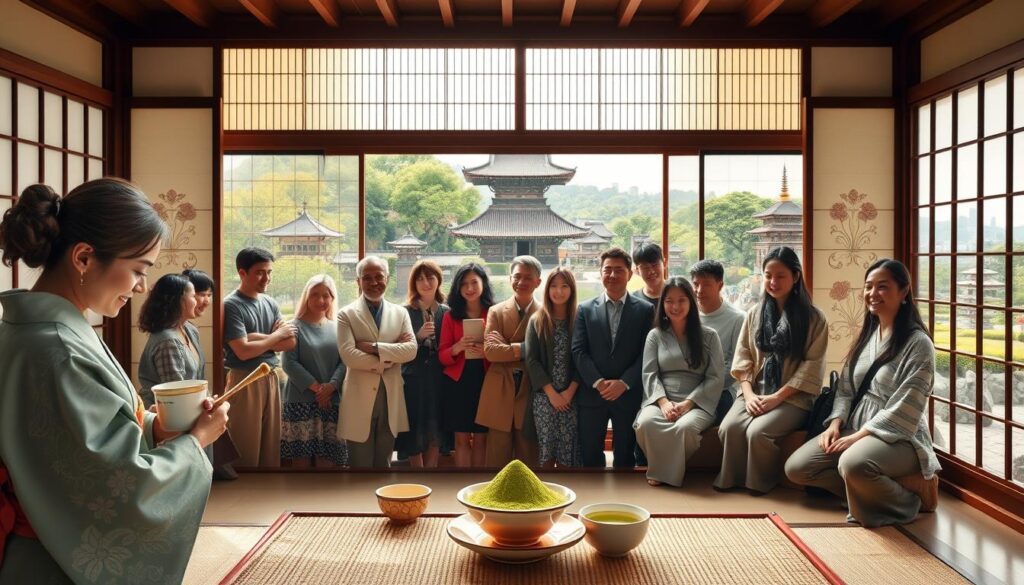
Looking at Japanese tea culture around the globe, we see it’s always changing. It stays true to its main values of harmony, respect, purity, and calm. This change affects many, inspiring them to find their special moments with tea. It helps us connect with others, bringing together different cultures.
Preserving the Tradition
As you explore Chanoyu, you may see the challenges it faces today. Modern life and its fast pace can hide the ceremony’s true values, like mindfulness. Still, people are determined to keep Chanoyu alive, thanks to those who love this art.
To keep the tea ceremony’s spirit alive, many are taking steps. Local tea schools and groups aim to teach both experts and beginners. They organize workshops to show how important this tradition is. Through these, anyone can help keep Chanoyu going for new generations.
The future of Chanoyu relies on our interest in its history. By being part of preservation efforts, we ensure it continues. Embracing Chanoyu lets us see its importance and helps keep it alive in today’s world.

